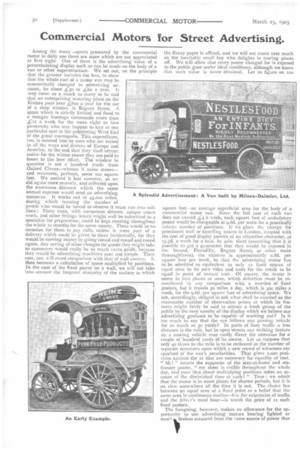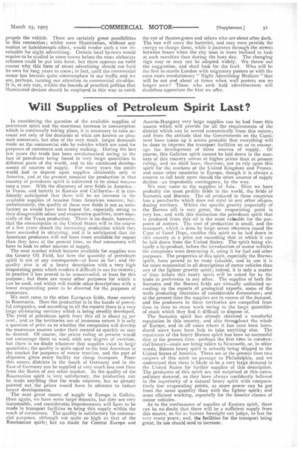Commercial Motors for Street Advertising.
Page 26

Page 27

If you've noticed an error in this article please click here to report it so we can fix it.
Among the many .spects presented by the commercial motor in daily use there are some which are not appreciated at first sight. One of them is the advertising value of a perambulating display such as can be made on the body of a van or other superstructure. We set out, on the principle that the greater includes the less, to show that the whole cost of a motor van may be economically charged to advertising account, let alone 450 or ,4;6o a year. it may come as a shock to many to be told that an enterprising watering place On the Riviera pays over ,;600 a year for the use of a shop window in Regent Street. A space which is strictly limited and fixed to a meagre frontage commands more than ,,Z.12 a week for the mere right to face passers-by who may happen to ha:t at one particular spot in the palpitating West End of the great cosmopolis. This expenditure, too, is entered into by men who are versed in all the ways and devices of Europe and America, to the end that they shall attract notice for the winter resort they are paid to boom to the best effect. The window in question is not a hundred yards from Oxford Circus—whence it never moves— and measures, perhaps, some too square feet. We noticed it last summer, as we did again more recently, and•reflected upon the enormous distance which the same annual expense would send an advertising motorcar. It works out at 45,000 miles, during which running the number of people who would be breed to observe it must run into mulions! Three vans, with competent drivers, unique coach work, and other fittings which might well be submitted to a specialist for preparation, could be kept running throughout the whole 12 months for the same money. There would be no occasion for them to pay calls, unless it were part of a delivery which could be given to them incidentally, for they would be earning money by going round and round and round again. Any saving of other charges for goods they might take to customers would really be so much extra profit, because they would be advertising machines pure and simple. Their cost, too, will stand comparison with that of wall posters. It then becomes a calculation of space multiplied by positions. In the case of the fixed poster on a wall, we will not take into account the frequent obscurity of the surface to which
'10 01
/ 11471'
the flimsy paper is affixed, and we will not count over much on the inevitable small boy who delights in tearing pieces off. We will allow that every poster charged for is exposed to the public gaze under ideal conditions, although we know that such value is never obtained. Let us figure on too
square feet—an average superficial area for the body of a commercial motor van. Since the full cost of each van does not exceed L:4 a week, each square foot of ambulatory poster would be chargeable at 9.6d. per week for a practically infinite number of positions. if we place the charge for prominent wall or hoarding spaces in London, coupled with the cost of good display posters of an attractive character, at 13.3d. a week for a 6oin. by aoin. sheet (assuming that it is possible to get a guarantee that they would be exposed in the Strand, Piccadilly, Regent Street, or other main thoroughfares), the expense is approximately o.8d. per square foot per week, so that the advertising motor has to be admitted as equivalent to only 12 fixed spaces of equal area to its own sides and ends for the result to be equal in point of annual cost. Of course, the motor is never in two places at once, which defection must be remembered in any comparison with a number of fixed posters, but it travels 50 miles a day, which is 300 miles a week, for the 9.6d. per square foot of advertising space. We are accordingly, obliged to ask what shall be counted as the reasonable number of observation points at which its features might fairly be said to attract a fresh group of the public by the very novelty of the display which we believe our advertising geniuses to be capable of working out? Is it too much to say that the eye follows any passing vehicle for as much as so yards? In parts of busy traffic a less distance is the rule, but in open streets any striking feature on a moving vehicle may easily direct the attention for a couple of hundred yards of its course. Let us suppose that only ao times to the mile is to be reckoned as the number of separate occasions upon which a new crowd of witnesses are apprised of the van's peculiarities. That gives 2,000 positions against the /2 that are necessary for equality of cost. " Ah ! " retorts the supportet of the stay-at-home and stationary poster, "my sheet is visible throughout the whole day, and your idea about multiplying positions takes no account of the diminished time at each ! " True : we admit that the motor is in more places for shorter periods, but it is on view somewhere all the time it is out. The choice lies between an equal area at a fixed point or a belief that the same area in continuous motion-1).1r the exigencies of traffic and the drivo r's meal hour—is worth the price of 12 such fixed posters.
The foregoing, however, makes no allowance for the opportunity to use advertising 'motors bearing lighted or
movi• devices actuated from the ,ame source of power that lio
propels the vehicle. There are certainly great possibilities in this connection ; whilst mere illumination, without any motion or kaleidoscopic effect, would render such a van invaluable for night advertising. Certain local by-laws would require to be studied in some towns before the more elaborate schemes could be put into force, but there appears no valid reason why this form of street advertising should not hold its own for long years to come; in fact, until the commercial motor has become quite commonplace in our traffic and we are, perhaps, turning our attention to commercial air-ships. It is, at any rate, within the bounds of practical politics that illuminated devices should be employed in this way to catch the eye of theatre-goers and others who are about after dark. The van will carry the batteries, and may even provide the energy to charge them, while it journeys through the streets between hours when the city man is more inclined to look at such novelties than during the busy day. The changing sign may or may not be adopted widely. We throw out the suggestion, and shall look for the fruit. Who will be the first to startle London with migratory posters or with the even more revolutionary " Night Advertising Medium "that will be out and about at times when wall posters are no longer seen? Those who seek bold advertisement will doubtless appreciate the hint we offer.




























